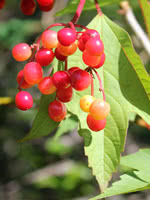Mon-Fri 9am - 5pm Mountain time
Common Blueberry vs Redwing Highbush Cranberry
Vaccinium myrtilloides
Viburnum trilobum JN Select
NOT AVAILABLE THIS SEASON - MIGHT RETURN
NOT AVAILABLE THIS SEASON - MIGHT RETURN
Common Blueberry is an August maturing berry that is wonderfully flavorful and contain more antioxidants by volume than the highbush varieties.
They'll give your baked goods a wonderful pop of flavor.
It isn't as large, pretty, or high yielding as the other varieties we carry. But Common Blueberry is one of the only blueberries that will survive in plant hardiness zones 1A to 2B.
Note: Blueberries require very specific soil conditions. They need well-drained soil with a pH between 4.5 and 5.0.
The Redwing Highbush Cranberry is a dense multi-stemmed shrub that blooms with white pinwheel shaped flowers in spring. It produces small, red, and edible berries in late summer. Its leaves are green, but the tips become more saturated with red throughout the season, and then turn a stunning crimson colour in the fall.
The Redwing Highbush Cranberry makes a good addition to any urban garden or hedge, and its berries are commonly used to liven up preserves with their tart flavor.

